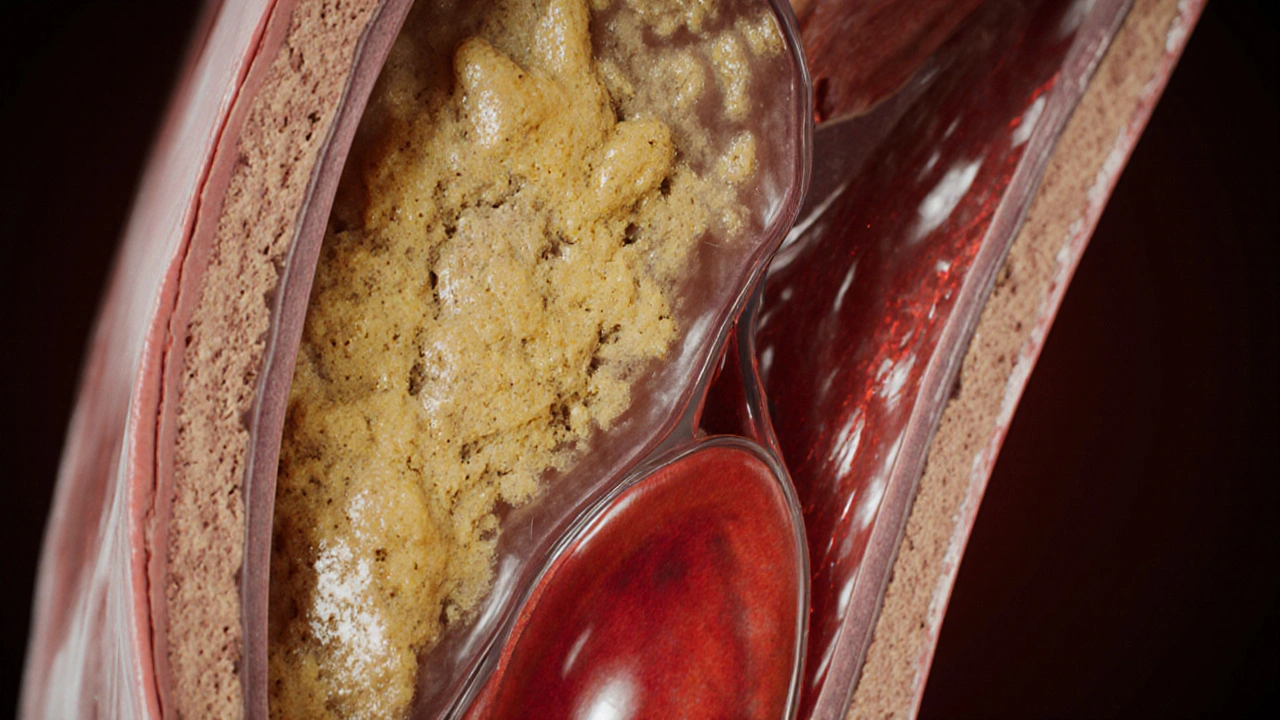Cholesterol Improvement Tracker
Your Cholesterol Goals
Track your progress on the top 10 lifestyle changes to manage cholesterol levels.
Your Progress Summary
Projected LDL Reduction:
0%
Projected HDL Increase:
0 mg/dL
Implementation Score:
Recommendations
Implement these lifestyle changes to achieve better cholesterol management:
Checklist of Recommended Actions
Include foods rich in soluble fiber and plant sterols.
Aim for 150 minutes of moderate activity weekly.
Target a BMI between 18.5-24.9.
Improves HDL levels and arterial health.
Moderation is key: up to one drink/day for women, two for men.
Avoid high-fructose corn syrup and sugary drinks.
Replace saturated fats with omega-3s.
Incorporate mindfulness and relaxation techniques.
Get 7-9 hours of uninterrupted sleep nightly.
Schedule annual fasting lipid panels.
Struggling with high cholesterol numbers? You don’t need a prescription‑only fix. By tweaking everyday habits, you can keep hypercholesterolemia at bay and protect your heart for the long run.
Key Takeaways
- Hypercholesterolemia is often driven by diet, weight, and stress, not just genetics.
- Ten evidence‑based lifestyle tweaks can lower LDL cholesterol by 10‑30%.
- Consistent monitoring lets you see results and stay motivated.
What Is Hypercholesterolemia?
When blood levels of hypercholesterolemia are persistently high, the condition is known as hypercholesterolemia, a major risk factor for cardiovascular disease, the arteries can become clogged with fatty plaques. The culprits are usually high LDL cholesterol the "bad" cholesterol that carries cholesterol from the liver to the arteries and low HDL cholesterol the "good" cholesterol that helps remove excess cholesterol from the bloodstream. While genetics play a role, lifestyle choices account for up to 70% of the variation in blood lipid levels.
Why Lifestyle Matters
Every day you eat, move, and stress, you’re either feeding or fighting that cholesterol buildup. Small, consistent changes compound over months, shifting the balance toward lower LDL and higher HDL. The good news? You control most of those variables.
Top 10 Lifestyle Changes
-
Adopt a Heart‑Healthy Diet
Focus on foods rich in soluble fiber a type of fiber that binds cholesterol in the gut and helps expel it (oats, beans, apples) and plant sterols naturally occurring substances that block cholesterol absorption. Swap butter for olive oil and include a handful of nuts daily.
-
Increase Physical Activity
Aim for at least 150 minutes of moderate physical activity such as brisk walking, cycling, or swimming each week. Exercise boosts HDL and can lower LDL by 5‑10%.
-
Maintain a Healthy Weight
Even a 5‑10% weight loss improves cholesterol profiles. Track your body mass index (BMI) a simple calculation of weight divided by height squared and aim for 18.5‑24.9.
-
Quit Smoking
Smoking lowers HDL and damages arterial walls. Within weeks of quitting, HDL rises and the risk of plaque formation drops.
-
Limit Alcohol Intake
Moderation is key: up to one drink per day for women, two for men. Excess alcohol raises triglycerides and can push LDL higher.
-
Reduce Added Sugars
High‑fructose corn syrup and sugary drinks spike triglycerides, which often travel with LDL particles. Swap soda for water or herbal tea.
-
Choose Healthy Fats
Replace saturated fats with omega‑3 fatty acids polyunsaturated fats found in fatty fish, flaxseed, and walnuts that lower triglycerides and modestly reduce LDL. Aim for two servings of oily fish per week.
-
Manage Stress
Chronic stress triggers cortisol spikes, which can raise LDL. Incorporate mindfulness, meditation, or a 10‑minute walk after a stressful task.
-
Prioritize Quality Sleep
Getting 7‑9 hours of uninterrupted sleep stabilizes hormones that influence appetite and lipid metabolism. Poor sleep is linked to higher LDL and lower HDL.
-
Regular Blood Lipid Monitoring
Schedule a fasting lipid panel at least once a year. Tracking trends helps you fine‑tune diet and exercise and shows your doctor when medication might be needed.
How to Implement the Changes
- Plan meals ahead: Spend Sunday prepping oats, bean salads, and veggie trays to avoid last‑minute fast food.
- Set SMART exercise goals: Specific, Measurable, Achievable, Relevant, Time‑bound - e.g., “Walk 30minutes every weekday at 7am.”
- Use a tracking app: Log food, steps, and weight. Many free apps color‑code cholesterol‑friendly foods.
- Replace one habit at a time: Quit smoking before cutting back on alcohol; success builds confidence.
- Schedule a reminder: Put a calendar alert for your yearly lipid test.
Common Pitfalls & How to Avoid Them
People often think “a single salad fixes everything.” In reality, consistency beats occasional extremes. Here’s what trips folks up:
- “All‑or‑nothing” mindset: If you miss a workout, don’t abandon the plan. Do a shorter session instead.
- Relying on “low‑fat” labels: Many low‑fat products add sugar, which can raise triglycerides. Read the ingredient list.
- Ignoring portion size: Even healthy foods add up. Use a kitchen scale for nuts and oils for the first few weeks.
- Skipping the follow‑up test: Without data, you won’t know if changes are working.

Quick Checklist
- Eat at least 25g of soluble fiber daily.
- Include a source of plant sterols (e.g., fortified spreads) a few times per week.
- Exercise 150min/week of moderate activity.
- Maintain BMI <25.
- Quit smoking and limit alcohol.
- Swap sugary drinks for water.
- Consume omega‑3 rich foods twice weekly.
- Practice stress‑reduction techniques daily.
- Sleep 7‑9hours each night.
- Get a fasting lipid panel at least annually.
Comparison of Lifestyle Changes and Expected LDL Impact
| Change | Typical LDL Drop | Time to See Effect |
|---|---|---|
| Heart‑healthy diet (soluble fiber, plant sterols) | 5‑10% | 4‑6 weeks |
| Regular aerobic exercise | 5‑8% | 6‑8 weeks |
| Weight loss (5‑10% body weight) | 7‑15% | 3‑6 months |
| Quit smoking | 3‑7% | 2‑4 weeks |
| Increase omega‑3 intake | 4‑6% | 8‑12 weeks |
Frequently Asked Questions
Can diet alone normalize cholesterol?
For many people, a combination of high‑fiber, low‑saturated‑fat foods and regular exercise can bring LDL into the target range. However, genetics or severe metabolic issues may still require medication.
How often should I get a lipid panel?
If you have no cardiovascular risk factors, an annual test is sufficient. With a family history or existing risk, your doctor may suggest testing every 6‑12 months.
Are there quick fixes for cholesterol?
Short‑term tricks like a single day of a very low‑fat diet can temporarily lower LDL, but lasting change requires sustained lifestyle habits.
Does stress really affect cholesterol?
Chronic stress raises cortisol, which can increase LDL and lower HDL. Managing stress with meditation, yoga, or regular walks helps keep those numbers stable.
What’s the role of HDL in heart health?
HDL acts like a cleanup crew, ferrying excess cholesterol back to the liver for disposal. Higher HDL levels are linked to a lower risk of plaque buildup.
Next Steps
Pick one change from the list, set a concrete goal for the next two weeks, and log your progress. After the trial period, add a second habit. Over time you’ll build a powerful routine that keeps hypercholesterolemia at a safe distance.


Comments
Roger Bernat Escolà
October 8, 2025 AT 14:44Wow, reading this feels like a lifeline for my heart! The list is clear, like a beacon in the night. I can already picture myself swapping chips for oats and hitting the park daily. Every step, even tiny, seems to whisper hope. If I stick to it, maybe my cholesterol will finally stop haunting me.
Allison Metzner
October 9, 2025 AT 12:57One must wonder who profits from these glossy checklists. Behind the friendly tones lurks a data‑harvesting machine, feeding pharma giants. The "heart‑healthy" label is just a veneer for endless consumerism. I'd advise a critical eye before buying any app that promises miracles. Trusting the system without question is a gamble you can't afford.
william smith
October 10, 2025 AT 11:11Start by swapping refined carbs for whole grains; fiber helps pull cholesterol out of the bloodstream. Add a daily serving of fatty fish, like salmon, for omega‑3s that boost HDL. Consistent activity, even a brisk 30‑minute walk, rounds out the plan.
Timothy Javins
October 11, 2025 AT 09:24Those tips ignore genetic factors completely.
Kay Yang
October 12, 2025 AT 07:37Love the practical vibe of this list 😊. Small changes feel doable, especially the sleep and stress bits. I’ve found a short meditation app that really calms me before bed. Keep sharing these nuggets, they’re gold!
Rajesh Kumar Batham
October 13, 2025 AT 05:51Exactly! 🌱 Little habits add up, and the emojis make it fun. I switched to oat milk and felt less bloated, plus my LDL dropped a bit. Consistency is the secret sauce, no need for extreme diets.
Bill Gallagher
October 14, 2025 AT 04:04Let me begin by saying that the notion of a tidy ten‑point checklist, while attractive, is fundamentally an oversimplification, the human body, in its magnificent complexity, does not respond to dietary tweaks in a linear, predictable fashion, instead, it reacts to a tapestry of genetic predispositions, microbiome variations, and environmental stressors, therefore, reducing hypercholesterolemia to merely "eat more oats, walk more" neglects the nuanced interplay of hormones, insulin sensitivity, and even circadian rhythms, which can modulate lipid metabolism in ways that short articles rarely acknowledge, additionally, the recommendation to "choose healthy fats" fails to distinguish between monounsaturated, polyunsaturated, and trans fats, each of which carries distinct metabolic pathways, while omega‑3 fatty acids are indeed beneficial, they must be balanced against omega‑6 intake, otherwise inflammation may paradoxically increase, the advice to "limit alcohol" is also context‑dependent; a glass of red wine might confer cardiovascular benefits for some, yet exacerbate triglyceride levels for others, furthermore, the emphasis on "regular blood lipid monitoring" is commendable, but without a clear understanding of target ranges, patients may become confused, it is crucial to engage a qualified healthcare professional who can interpret trends over time, rather than obsess over single measurements, the role of stress management, often relegated to a footnote, deserves a prominent place, as chronic cortisol elevation is known to raise LDL and lower HDL, mindfulness practices, aerobic exercise, and adequate sleep form a triad that synergistically improves lipid profiles, yet, many guidelines overlook socioeconomic barriers that limit access to fresh produce or safe spaces for exercise, policy interventions, such as subsidizing whole grains or creating community walking trails, can bridge this gap, in summary, while the ten steps provide a helpful framework, they must be integrated into a personalized, evidence‑based strategy, otherwise, patients risk following a one‑size‑fits‑all regime that may yield minimal benefit, and could become disillusioned, abandoning healthier habits altogether.
Rajashree Varma
October 15, 2025 AT 02:17Great points, Bill, and I appreciate the depth you bring. It reminds us that health is not a simple checklist. Still, the ten steps can serve as a starting line. Even small actions can spark bigger changes over time. Let’s keep the momentum going, celebrating each win. Your thoroughness helps us see the bigger picture. Together we can blend science with everyday life. Stay hopeful and keep moving forward.
Anshuman Pandey
October 16, 2025 AT 00:31Indeed, the journey of lowering cholesterol mirrors the path of self‑discovery. Each habit we adopt reflects a choice about who we wish to become. Simplicity in practice can coexist with complexity in understanding. The mind and body negotiate in silent dialogue. By honoring both, we create sustainable change. Keep pondering, keep acting.
Thomas Malloy
October 16, 2025 AT 22:44Seems solid, worth a try.
Sushma Gowda
October 17, 2025 AT 20:57Absolutely, give it a go and track how you feel. Small wins build confidence, and confidence fuels bigger goals. If you hit a snag, remember it’s okay to adjust the plan. You’ve got this, keep at it!